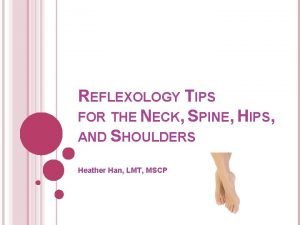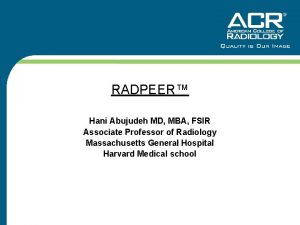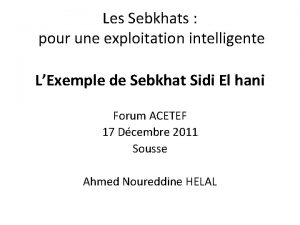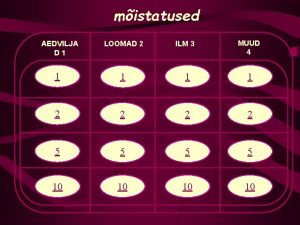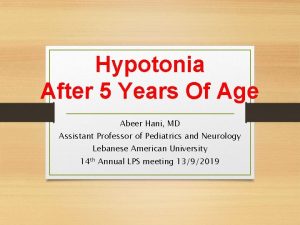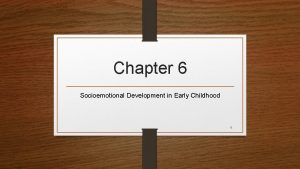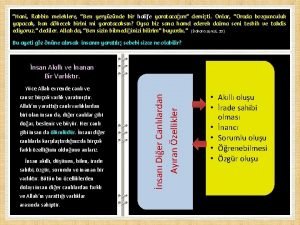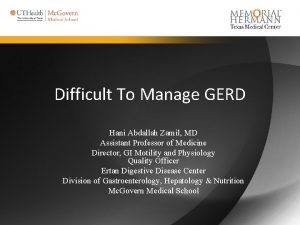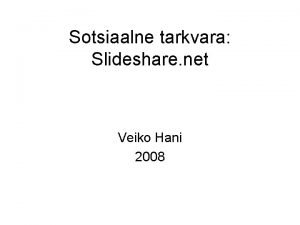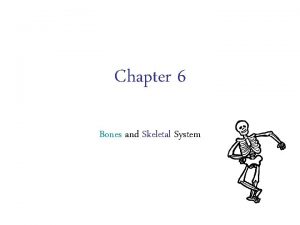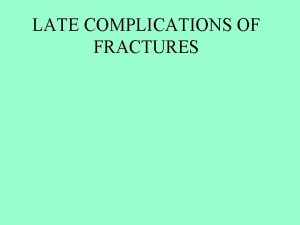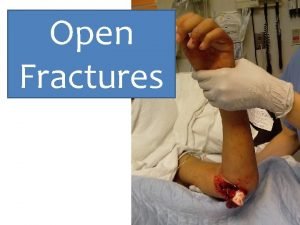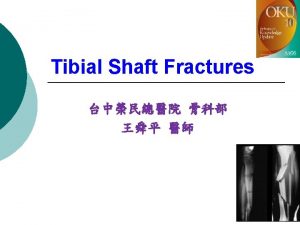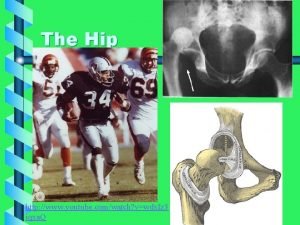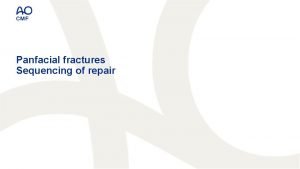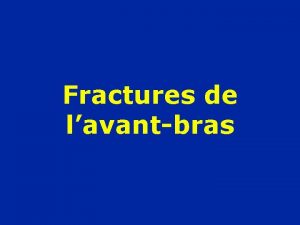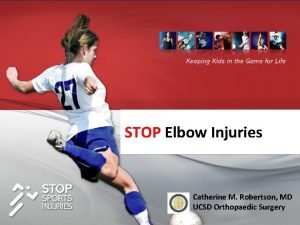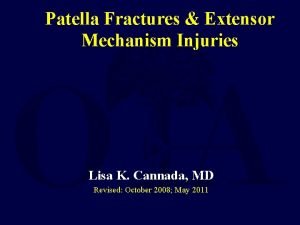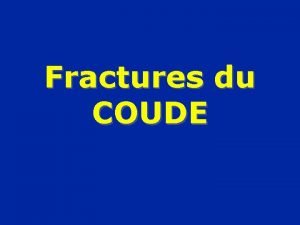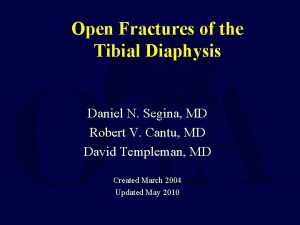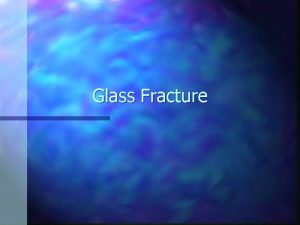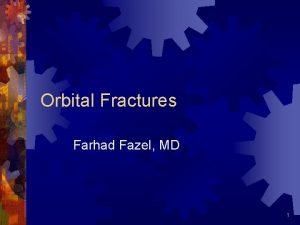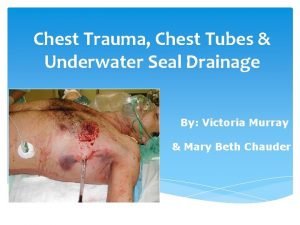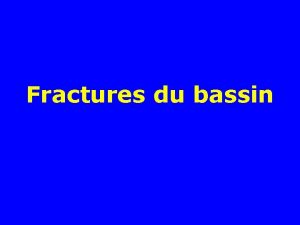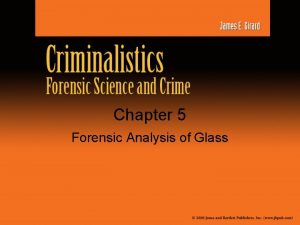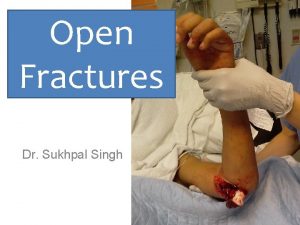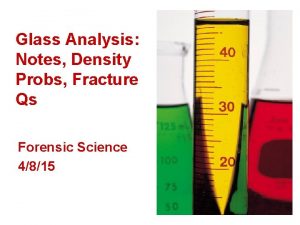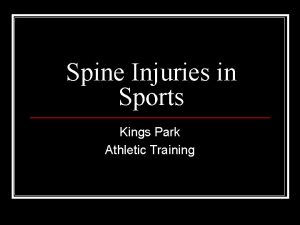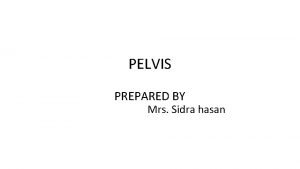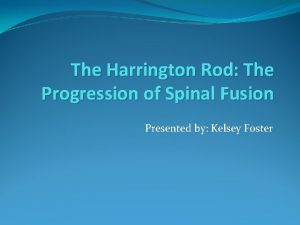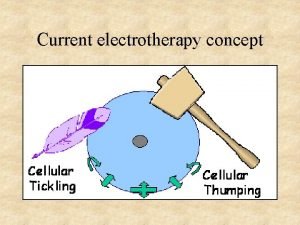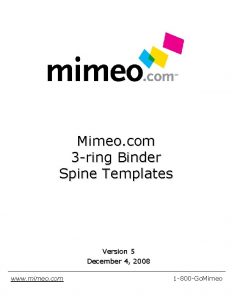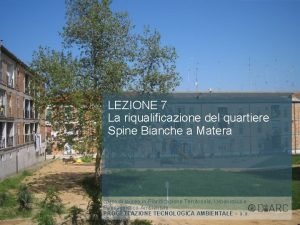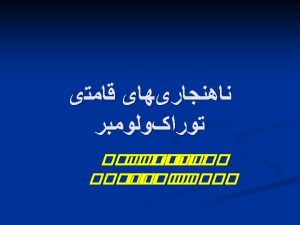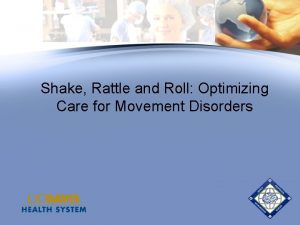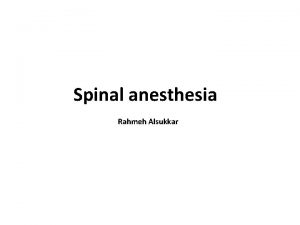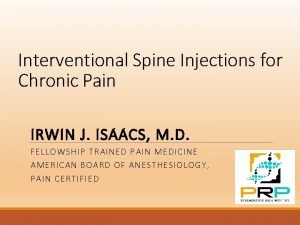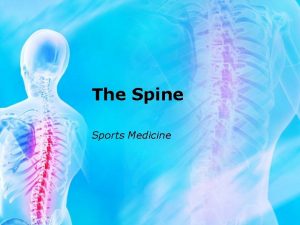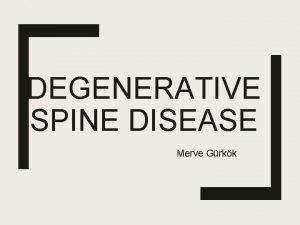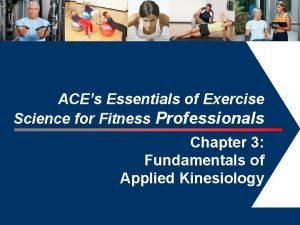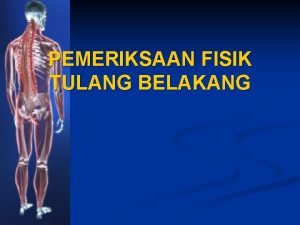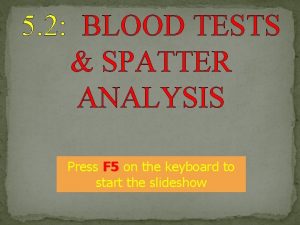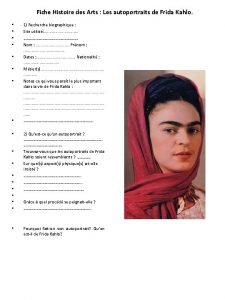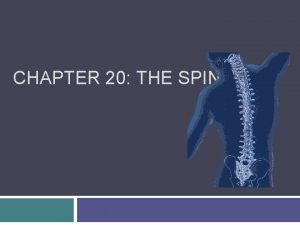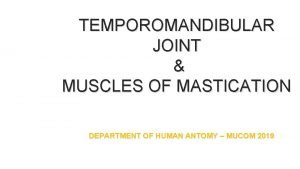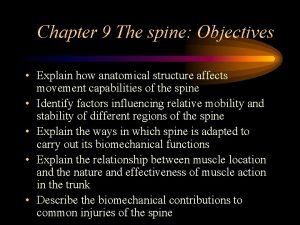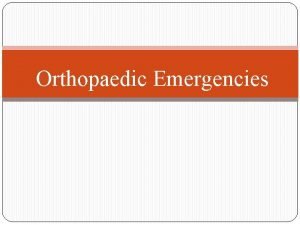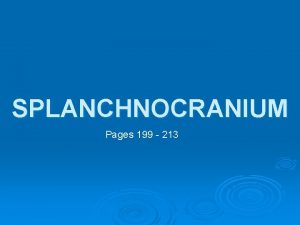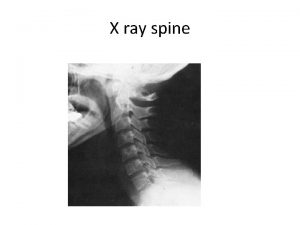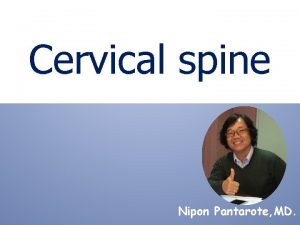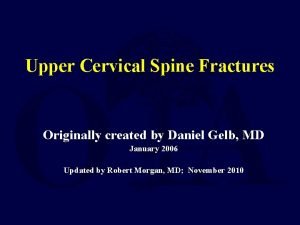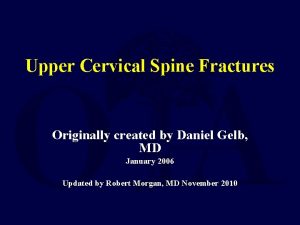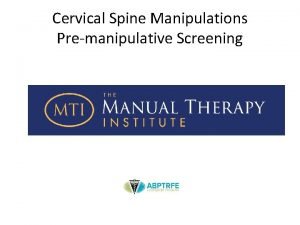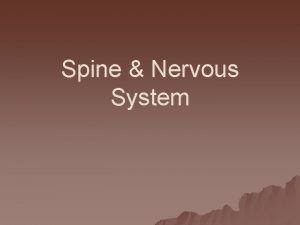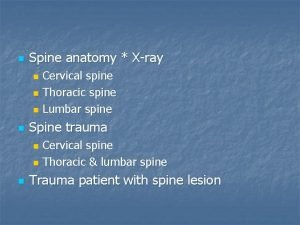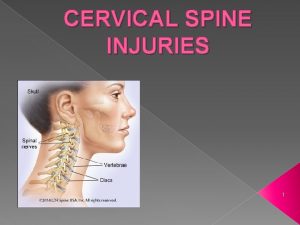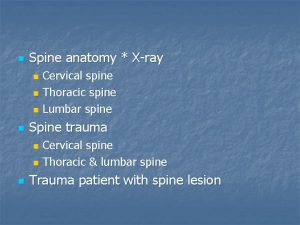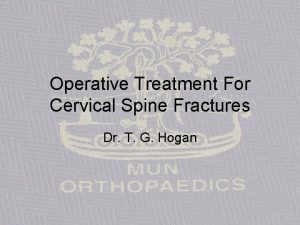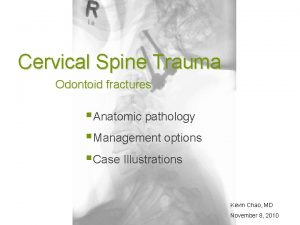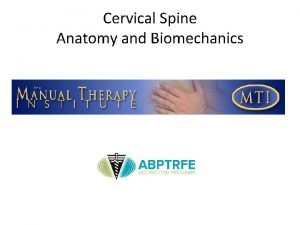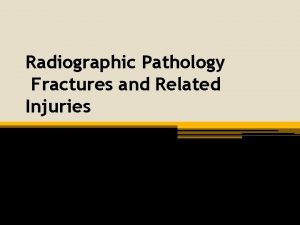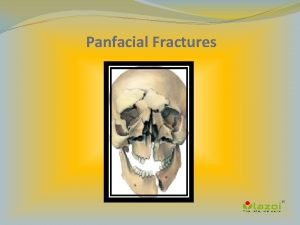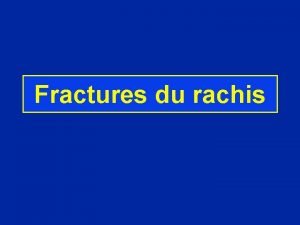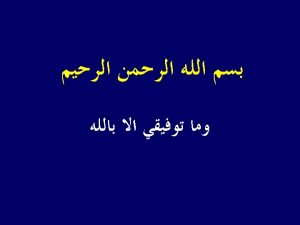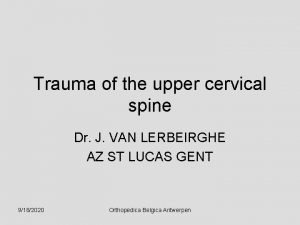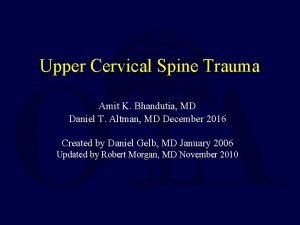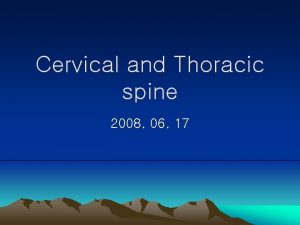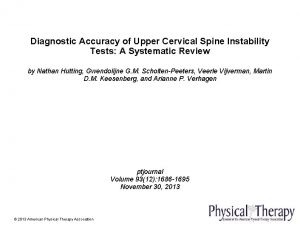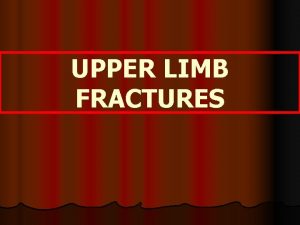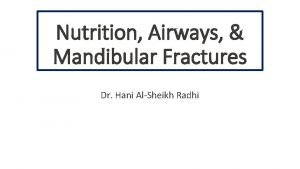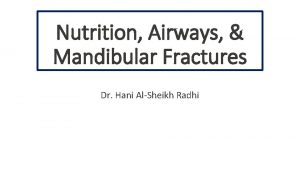Upper Cervical Spine Fractures Dr Hani Alsulaimany Upper





























































- Slides: 61

Upper Cervical Spine Fractures Dr Hani Alsulaimany

Upper Cervical Spine Fractures • • • Epidemiology Anatomy Imaging Characteristics Common Injuries Management Issues

Epidemiology • 717 cervical spine fractures in 657 patients over 13 years • C 1 and Hangman fractures found more in the young – Odontoid fractures evenly distributed • Younger patients have higher energy injuries • C 2 fractures most common The epidemiology of fractures and fracture-dislocations of the cervical spine Ryan, M. D. ; Henderson, J. J. Injury, 1992, 23, 1, 38 -40

Upper Cervical Anatomy

Upper Cervical Anatomy • Biomechanically Specialized – Support of “large” Cranial mass – Large range of motion • Flexion/extension • Axial rotation • Unique osteological characteristics

Large Cranial Mass Keel below the SNL is thick bone Roberts, DA; Doherty, BJ; Heggeness MH. Quantitative Anatomy of the Occiput and the Biomechanics of Occipital Screw Fixation Spine 23(10), 15 May 1998, pp 1100 -1107

The course of the vertebral artery through C 1 and C 2 determines the possibility of placing screws for fixation of fractures and dislocations • C 1 lateral mass screws • C 1 -2 transarticular screws • C 2 pedicle/pars screws

Normal Vertebral Artery

Tortuous Vertebral Artery

C 1 - Atlas • No body • 2 articular pillars – Flat articular surface – Vertebral artery foramen • 2 arches – Anterior – Posterior • Vertebral artery groove

C 2 Anatomy • Dens – Embriological C 1 body – Base poorly vascularized – Osteoporotic • Flat C 1 -2 joints • Vertebral artery foramena – Inferomedial to superolateral

Anatomy – The Ligaments • Allow for the wide ROM of upper C-spine while maintaining stability • Classified according to location with respect to vertebral canal – Internal: • Tectorial membrane • Cruciate ligament – including transverse ligament • Alar and apical ligaments – External • Anterior and posterior atlanto-occipital membranes • Anterior and posterior atlanto-axial membranes • Articular capsules and ligamentum nuchae

Atlanto-Axial Anatomy Tectorial Membrane

Atlanto-Axial Anatomy Tranverse Ligament C 1 -C 2 joint Occiput C 1 C 2 Alar Ligament

Atlanto-Axial Anatomy Facet for Occipital Condyle Transverse Ligament

Vertebral Artery Atlanto-Axial Anatomy

Radiographic Evaluation

Plain Radiographic Evaluation Lateral View Prevertebral Swelling Soft Tissue Shadow <6 mm at C 2 Concave/Flat Pre-dental space < 3 mm Atlanto-Occipital Joint Congruence Radiographic Lines* Open Mouth AP Distraction C 1 -2 Symmetry

Radiographic Diagnosis – Screening Lines Harris’s lines Powers’s Ratio

Radiographic Lines Harris’ Lines Basion-Dental Interval (BDI) Basion to Tip of Dens <12 mm in 95% >12 mm ABNORMAL Basion-Axial Interval (BAI) Basion to Posterior Dens -4 -12 mm in 98% >12 mm Anterior Subluxation >4 mm Posterior Subluxation Harris et al, Am J Radiol, 1994

Radiographic Lines Powers’ Ratio • BC/OA – >1 considered abnormal • Limited Usefulness • Positive only in Anterior Translational injuries • False Negative with pure distraction Powers et al, Neurosurg, 1979

Radiographic Diagnosis CT Scan Same rules as with plain films Better visualization of cranio-cervical junction Subluxation Focal hematomas Occipital condyle fractures Dens fractures

Radiographic Diagnosis MRI Increased Signal Intensity in : C 0 -C 1 Joint C 1 -2 Joint Spinal Cord Cranio-cervical ligaments Pre-vertebral soft tissues Dickman et al, J Neurosurg, 1991 Warner et al, Emerg Radiol, 1996

Upper Cervical Spine Fractures • Common Injuries – Occipital Condyle Fracture – Craniocervical sprain? – C 1 ring injuries – Odontoid Fracture – Hangman’s Fracture • Uncommon Injuries – Craniocervical Dislocation – Rotatory subluxation

Occipital Condyle Fracture Type I Impaction Fracture Type II Extension of basilar skull fracture Type III ALAR ligament Avulsion Anderson , SPINE 1988 Tuli, NEUROSURGERY, 1997

Cranio-cervical Dislocation • • Antlanto-Occipital Joint Occipito-Cervical Joint Cranio-cervical Joint Atlanto-Axial Joint

Cranio-cervical sprain (stage 1) may be treated nonoperatively

Cranio-cervical Dislocation Commonly Fatal Present 6 -20% of post mortem studies – Alker et al, 1978 – Bucholz & Burkhead, 1979 – Adams et al, 1992 50% missed injury rate 1/3 Neurological Worsening – Davis et al, 1993


Cranio-cervical Dislocation Treatment Emergency Room Collar/sandbag Halo vest Definitive Posterior occipital cervical fusion ALWAYS include C 1 and C 2

Atlas Fractures - Treatment Collar 1. Isolated anterior arch 2. Isolated posterior arch 3. Non-displaced Jefferson fracture

Atlas Fractures - Treatment Displaced <6. 9 mm Halo vest * 3 mos Displaced >6. 9 mm Halo traction (reduction) * several weeks followed by halo vest Immediate halo vest Posterior C 1 -2 fusion (unable to tolerate halo) After brace treatment complete confirm C 1 -2 stability Flexion/extension films C 1 -2 fusion for ADI > 5 mm

Transverse ligament avulsion Bony avulsions may heal with nonoperative management TAL rupture does not heal with nonoperative management and requires C 1 -C 2 arthrodesis

Atlas Fractures - Treatment Fusion options Gallie Post-op halo Brooks Jenkins Transarticular Screws C 1 lateral mass/C 2 pars-pedicle screws

Odontoid Fractures Most common fracture of Axis (nearly 2/3 of all C 2 Fxs) 10 – 20 % of all cervical fractures Etiology Bimodal distribution Young - high energy, multi-trauma Elderly - low energy, isolated injury (most common C-spine Fx elderly)

Elderly and the Odontoid • Platzer Studies – Elderly increased pseudarthrosis rate( 12% v. 8%) – Elderly tolerated pseudarthosis well(1/5) – Elderly tolerated halo well – 10% mortality (4/41) – 22% complication rate • Chapman studies – Elderly did not heal the odontoid fracture (4/17) – Elderly tolerated halo well (7/8) – 15% mortality (3/20) • Harrop and Vaccaro – 9/10 “union” – 5/10 postop halo – 1/10 perioperative death • Multiple series of high mortality rates Anterior screw fixation of odontoid fractures comparing younger and elderly patients. Authors: Platzer, P. ; Thalhammer, G. ; Ostermann, R. ; Wieland, T. ; Vecsei, V. ; Gaebler, C. Source: Spine, 2007, 32, 16, 1714 -1720, United States Nonoperative management of odontoid fractures using a halothoracic vest. Authors: Platzer, P. ; Thalhammer, G. ; Sarahrudi, K. ; Kovar, F. ; Vekszler, G. ; Vecsei, V. ; Gaebler, C. Source: Neurosurgery, 2007, 61, 3, 522 -9; discussion 529 -30, United States Posterior atlanto-axial arthrodesis for fixation of odontoid nonunions. Authors: Platzer, P. ; Vecsei, V. ; Thalhammer, G. ; Oberleitner, G. ; Schurz, M. ; Gaebler, C. Source: Spine, 2008, 33, 6, 624 -630, United States Type II odontoid fractures in the elderly: early failure of nonsurgical treatment. Authors: Kuntz, C. , 4 th; Mirza, S. K. ; Jarell, A. D. ; Chapman, J. R. ; Shaffrey, C. I. ; Newell, D. W. Source: Neurosurg. Focus. , 2000, 8, 6, e 7, United States Efficacy of anterior odontoid screw fixation in elderly patients with Type II odontoid fractures. Authors: Harrop, J. S. ; Przybylski, G. J. ; Vaccaro, A. R. ; Yalamanchili, K. Source: Neurosurg. Focus. , 2000, 8, 6, e 6, United States

Fracture Classification Anderson and D’Alonzo Type I 2 % (2/49) Type II 50 -75 % (32/49) Type III 15 -25 % (15/49) Fractures of the odontoid process of the axis. Authors: Anderson, L. D. ; D'Alonzo, R. T. Source: J. Bone Joint Surg. Am. , 1974, 56, 8, 1663 -1674, UNITED STATES

Subtypes of Type II Fractures • Type IIA and B are amenable to anterior fixation • Type IIC is not • Does not include part of facet, not a Type III Grauer, J. N et al Proposal of a modified, treatment-oriented classification of odontoid fractures. Spine J. , 2005, 5, 2, 123 -129

Acute Management • Spinal cord injury rare (17/226) • Airway compromise – 0/8 nondisplaced – 1/21 anterior displacement – 13/32 posterior displacement (2 deaths) Don’t do flexion reductions! Epidemiolgy of spinal cord injury after acute odontoid fractures JAMES S. HARROP, M. D. , ASHWINI D. SHARAN, M. D. , AND GREGORY J. PRZYBYLSKI, M. D. Neurosurgical Focus 2000 Closed management of displaced Type II odontoid fractures: more frequent respiratory compromise with posteriorly displaced fractures GREGORY J. PRZYBYLSKI, M. D. , JAMES S. HARROP, M. D. , AND ALEXANDER R. VACCARO, M. D. Neurosurgical Focus 2000

Definitive Treatment Options Type 1 C-Collar beware unrecognized CCD Evidence-based analysis of odontoid fracture management. Authors: Julien, T. D. ; Frankel, B. ; Traynelis, V. C. ; Ryken, T. C. Source: Neurosurg. Focus. , 2000, 8, 6, e 1, United States Type 3 C-Collar 10 -15% nonunion SOMI brace Halo Vest

Treatment Options odontoid fracture Type 2 • • • C-Collar SOMI / Minerva Halo Vest Odontoid Screw C 1 -2 posterior fusion

Anterior Odontoid Screw Fixation Indications • • • Displaced Type II, Shallow Type III Polytrauma patient Unable to tolerate halo-vest Early displacement despite halo-vest (Reduces in extension) • • Non-reducible odontoid fracture (Reduces in flexion) Body habitus (Barrel chest ) Associated TAL injury Subacute injury (> 6 months) Reverse oblique (elderly) Contraindications Roy-Camille Classification

Anterior Screw History Note reduced dorsal cortex

Anterior Screw Technique • Skin incision at C 5 • Note slight extension • Missing key element in diagram (need to atraumatically obtain open mouth fluoroscopy) • Biplanar fluoroscopy Direct anterior screw fixation for recent and remote odontoid fractures. Authors: Apfelbaum, R. I. ; Lonser, R. R. ; Veres, R. ; Casey, A. Source: J. Neurosurg. , 2000, 93, 2 Suppl, 227 -236, UNITED STATES

Anterior Screw Technique • Need to enter body caudal portion of promontory • Midline for single screw placement Direct anterior screw fixation for recent and remote odontoid fractures. Authors: Apfelbaum, R. I. ; Lonser, R. R. ; Veres, R. ; Casey, A. Source: J. Neurosurg. , 2000, 93, 2 Suppl, 227 -236, UNITED STATES

Anterior Screw Technique • Critical to cross rostral cortex • Critical to use lag screw technique • Limited support for second screw Direct anterior screw fixation for recent and remote odontoid fractures. Authors: Apfelbaum, R. I. ; Lonser, R. R. ; Veres, R. ; Casey, A. Source: J. Neurosurg. , 2000, 93, 2 Suppl, 227 -236, UNITED STATES

Posterior Odontoid Stabilization

Posterior Odontoid Stabilization • Options – Posterior wiring • Up to 25% pseudoarthrosis • Halo vest necessary (? ) Dickman JNS 1996, Grob Spine 1992 – Transarticular screw fixation • Magerl and Steeman Cerv Spine 1987 • Reilly et al, JSD 2003 – C 1 lateral mass - C 2 pars/pedicle/lamina screw

Wiring Techniques Biomechanical comparison of C 1 -C 2 posterior arthrodesis techniques. Authors: Papagelopoulos, P. J. ; Currier, B. L. ; Hokari, Y. ; Neale, P. G. ; Zhao, C. ; Berglund, L. J. ; Larson, D. R. ; An, K. N. Source: Spine, 2007, 32, 13, E 363 -70, United States

Trans-articular Screw Technique Primary posterior fusion C 1/2 in odontoid fractures: indications, technique, and results of transarticular screw fixation Authors: Jeanneret, B. ; Magerl, F. Source: J. Spinal Disord. , 1992, 5, 4, 464 -475, UNITED STATES

C 1 C 2 Segmental Instrumentation Posterior C 1 -C 2 fusion with polyaxial screw and rod fixation. Authors: Harms, J. ; Melcher, R. P. Source: Spine, 2001, 26, 22, 2467 -2471, United States


pedicle Pars Trans-articular C 2 pars/pedicle

Traumatic Spondylolisthesis Axis (Hangman’s Fracture) Second most common fracture of axis 25% of C 2 injuries Most common mechanism of injury is MVA

Hangman’s Fracture Younger age group (Avg 38 yrs) Usually due to hyperextension-axial compression forces (windshield strike) Neurologic injury seen in only 5 -10 % decompresses canal) Traditional treatment has been Halo-vest Collar adequate if < 6 mm displaced Coric et al JNS 1996 (acutely

Where Cranio-cervical meets Subaxial Levine AM, Edwards CC: The management of traumatic spondylolisthesis of the axis. J Bone Joint Surg Am 1985; 67: 217 -226

Hangman Fracture • Intact disk defines Type I • Halo treatment difficult with torn disk (types II and III) • Exercise caution Dysphagia and Dysphonia Resolved immediately with halo adjustment

Hangman’s Fracture Treatment Types II and III Treatment Posterior – Open reduction and C 1 -C 3 fusion – Direct pars repair and C 2 -C 3 fusion Anterior – C 2/C 3 ACDF with instrumentation

Atlanto-axial Rotatory Subluxation Fuentes et al Traumatic atlantoaxial rotatory dislocation with odontoid fracture: case report and review. Spine 2001; 26(7) 830 -834

Atlanto-axial Rotatory Subluxation • • Traction/halo Posterior fusion Lateral facetectomy, reduction, fusion Transoral facetectomy, reduction, fusion

Thank you
 Cervical spine reflexology
Cervical spine reflexology Hani abujudeh
Hani abujudeh Sidi el hani
Sidi el hani üks hani neli nina
üks hani neli nina Abeer saif age
Abeer saif age Jerome and hani get up early
Jerome and hani get up early Ben bir halife yaratacağım
Ben bir halife yaratacağım Dr hani zamil
Dr hani zamil Veiko hani
Veiko hani Tubular shaft of a long bone
Tubular shaft of a long bone Bone cancer fractures
Bone cancer fractures Algodystrophy
Algodystrophy Open fracture treatment
Open fracture treatment Gustilo anderson classification antibiotics
Gustilo anderson classification antibiotics Acetabular fractures
Acetabular fractures Panfacial fractures sequencing
Panfacial fractures sequencing Pronation main
Pronation main Irving elbow dislocation
Irving elbow dislocation Types of fractures with pictures
Types of fractures with pictures Fracture sus et intercondylienne du coude
Fracture sus et intercondylienne du coude Triradiate cartilage x ray
Triradiate cartilage x ray Classification of open fractures
Classification of open fractures Danis and weber classification
Danis and weber classification Concentric fracture glass definition
Concentric fracture glass definition Types of fractures with pictures
Types of fractures with pictures Chest tube bubbling in suction control chamber
Chest tube bubbling in suction control chamber Fracture de voillemier def
Fracture de voillemier def Types of glass fractures
Types of glass fractures Dr sukhpal singh
Dr sukhpal singh Concentric fractures
Concentric fractures Who is in charge when spine boarding an athlete and why
Who is in charge when spine boarding an athlete and why Sacral base and apex
Sacral base and apex Pubic arch
Pubic arch Harrington rod
Harrington rod Chapter 21 caring for head and spine injuries
Chapter 21 caring for head and spine injuries Macro current in electrotherapy
Macro current in electrotherapy Contact mimeo
Contact mimeo Quartiere spine bianche matera
Quartiere spine bianche matera 31 pairs of spinal nerves
31 pairs of spinal nerves The story spine
The story spine Sway back posture
Sway back posture Rattle spine nms
Rattle spine nms Lumbar puncture structures pierced
Lumbar puncture structures pierced Ans
Ans Cervical facet referral pattern
Cervical facet referral pattern Bones of the vertebral column
Bones of the vertebral column Scottie dog lumbar spine
Scottie dog lumbar spine Trunk extensors
Trunk extensors Schober spine
Schober spine Griffon ford model
Griffon ford model Nerve fibers
Nerve fibers Spinal cord anterior
Spinal cord anterior Emory spine center
Emory spine center What are sentinel injuries
What are sentinel injuries Spine blood spatter definition
Spine blood spatter definition Frida kahlo mes grands parents mes parents et moi analyse
Frida kahlo mes grands parents mes parents et moi analyse Chapter 20 worksheet the spine
Chapter 20 worksheet the spine Genial tubercle
Genial tubercle Spine vs thorn
Spine vs thorn Clinical biomechanics of the spine
Clinical biomechanics of the spine Gustilo anderson classification
Gustilo anderson classification Interalveolar septa
Interalveolar septa
